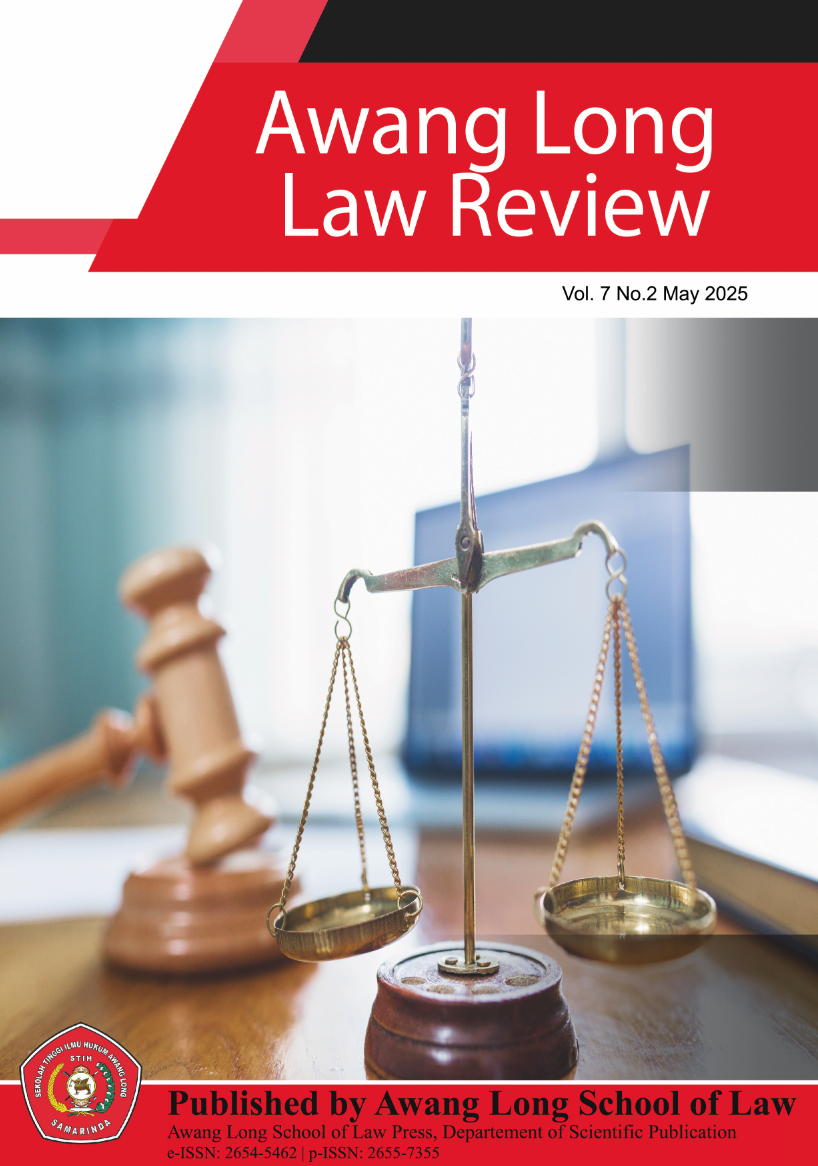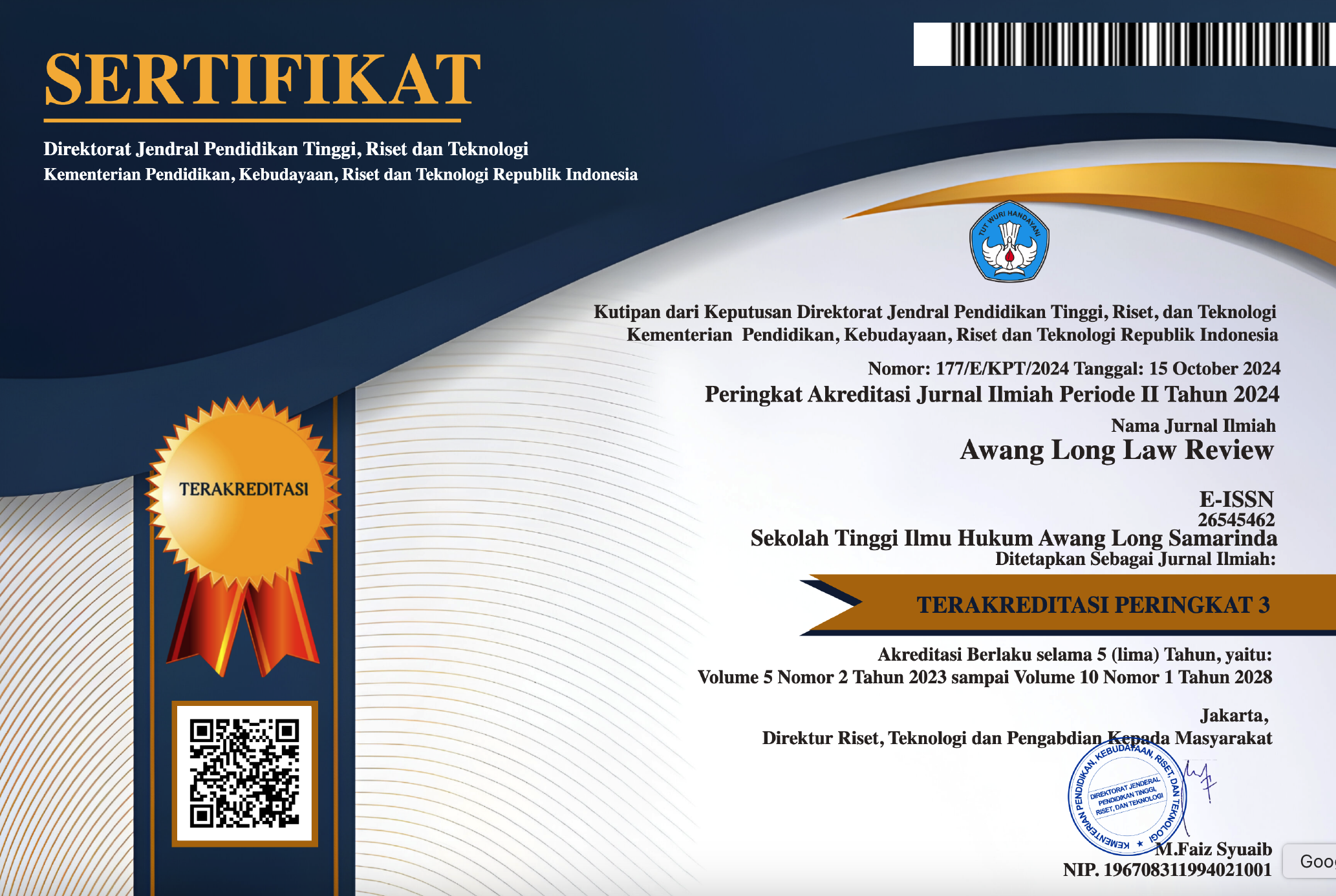RISK MITIGATION OF NEGATIVE PLEDGE COLLATERAL FOR SYNDICATED LOAN IN OIL AND GAS COMPANY
Abstract
Lending by banks carries the risk of default, which may affect the bank’s financial stability. To reduce this risk, banks apply prudential principles in syndicated loans, including the Negative Pledge mechanism, which prohibits debtors from encumbering their assets to other parties without creditor approval. However, as a state-owned company, PT P has limitations in using its assets as collateral, so using a Negative Pledge is an alternative solution. The challenge is that this clause has no specific regulation in Indonesia, which can weaken the creditor’s position in the credit agreement. This research aims to analyze the application of Negative Pledges in syndicated loans in the oil and gas sector and identify risk mitigation strategies for creditors in Indonesian law. The research method used is descriptive with a normative approach based on analysis of positive law, jurisprudence, and legal doctrine. The findings reveal that although the Negative Pledge clause provides significant protection to creditors, its implementation in Indonesia faces challenges due to the absence of specific regulations governing the clause in detail. Additional clauses such as Disposal Restrictions are recommended to mitigate risks, along with enhanced oversight through more stringent agreement mechanisms. This study offers practical contributions to banks in managing syndicated loan risks and provides new insights into the development of banking legal policies related to the Negative Pledge in Indonesia.
Downloads
References
Caraiman, A.-C. (2020). The Risk Management in Financing Decisions in Corporate Governance. Ovidius University Annals, Economic Sciences Series, 20(1), 859–865.
Creswell, J. W., & Creswell, J. D. (2018). Research Design Qualitative, Quantitative, and Mixed Methods Approaches. In SAGE Publications, Inc. (5th ed).
Darmawi, H. (2006). Pasar Finansial dan Lembaga-Lembaga Finansial. Jakarta: Bumi Aksara.
Fahmi, I. (2014). Analisis laporan keuangan. Alfabeta.
Gayo, M. F., & Sugiyono, H. (2021). Penerapan Asas Pacta Sunt Servanda Dalam Perjanjian Sewa Menyewa Ruang Usaha. JUSTITIA: Jurnal Ilmu Hukum Dan Humaniora, 8(3), 245–254.
Grigorieva, A. G. (2021). Grounds for the pledge occurrence. Uchenyy Sovet (Academic Council), 6, 444–459. https://doi.org/10.33920/nik-02-2106-04
Gumanti, R. (2012). Syarat Sahnya Perjanjian (Ditinjau dari KUHPerdata). Jurnal Pelangi Ilmu, 5(01).
Hardwick, R. (2017). The negative pledge and disposal restrictions: carve-outs and remedies for breach. Butterworths Journal of International Banking and Financial Law.
Hasbullah, F. H. (2002). Hukum kebendaan perdata: Hak-hak yang memberi kenikmatan. Ind Hill-Company.
Komara, A. (2014). Tinjauan Yuridis Obligasi Sebagai Objek Dalam Pernyataan Penjaminan Negatif (Negative Pledge). UIN Syarif Hidayatullah Jakarta.
Kulinich, T., Andrushko, R., Prosovych, O., Sternyuk, O., & Tymchyna, Y. (2023). Enterprise Risk Management in an Uncertain Environment. International Journal of Professional Business Review, 8(4), e01700. https://doi.org/10.26668/businessreview/2023.v8i4.1700
Lie, G. (2023). A Negative Pledge as an Alternative Solution to Achieve the Pari Passu Pro-Rata Parte Principle. International Journal of Sustainable Development and Planning, 18(1), 265–274. https://doi.org/10.18280/ijsdp.180128
Nasikan, N., Grynchuk, Y., & Vdovichena, O. (2021). Risk-Oriented Management of Corporate Enterprises in Modern Conditions. Ekonomika Ta Derzhava, 3, 71. https://doi.org/10.32702/2306-6806.2021.3.71
Peraturan Otoritas Jasa Keuangan Nomor 18/POJK.03/2016 Tahun 2016 Tentang Penerapan Manajemen Risiko Bagi Bank Umum (2016).
Rehman, H., Ramzan, M., Haq, M. Z. U., Hwang, J., & Kim, K.-B. (2021). Risk Management in Corporate Governance Framework. Sustainability, 13(9), 5015. https://doi.org/10.3390/su13095015
Soekanto, S., & Mamudji, S. (2014). Penelitian Hukum Normatif, Suatu Tinjauan Singkat, cet. 8. Jakarta: PT RajaGrafindo Perkasa.
Subekti, R., & Tjitrosudibio, R. (1999). Kitab undang-undang hukum perdata.
Tamasauskas, A. (2003). The negative pledge clause: An investigation into the remedies available to the original lender with special emphasis on the tort of interfering with contractual relations.
Tito and others v Waddell and others (No 2) (Ch. 106). (1977).
Tjahjono, M., Sugianto, F., & Susantijo, S. (2022). Kesesuaian Penggunaan Klausul Negative Pledge Of Assets dalam Perjanjian Kredit oleh Bank Umum dengan Prinsip Kehati-hatian: Tinjauan Perbandingan Hukum. Jurnal Hukum Magnum Opus, 5(1), 68–82. https://doi.org/10.30996/jhmo.v5i1.5932
Utama, D. I. S., Hawin, M., & Hariyanto. (2015). Tinjauan Yuridis Fasilitas Kredit Modal Kerja Yang Dijamin Kondisi Negative Pledge Dalam Operasional di PT. Bank Mandiri (Persero) Tbk. Universitas Gadjah Mada.
Vaughan, E. J., & Vaughan, T. (2007). Fundamentals of risk and insurance. John Wiley & Sons.
Wen, W., Tong, L., Xie, L., & Zhang, S. (2023). Stock Pledge by Controlling Shareholder and Corporate Social Responsibility*. Asia-Pacific Journal of Financial Studies, 52(5), 762–792. https://doi.org/10.1111/ajfs.12448
Wilson v Northampton and Banbury Junction Railway Co (9 Ch. App 279). (1874). https://www.lawteacher.net/cases/tito-v-waddell.php?vref=1
Wood, P. R. (1995). International loans, bonds and securities regulation. Sweet & Maxwell.
Copyright (c) 2025 Yudho Prabeswara

This work is licensed under a Creative Commons Attribution-ShareAlike 4.0 International License.







